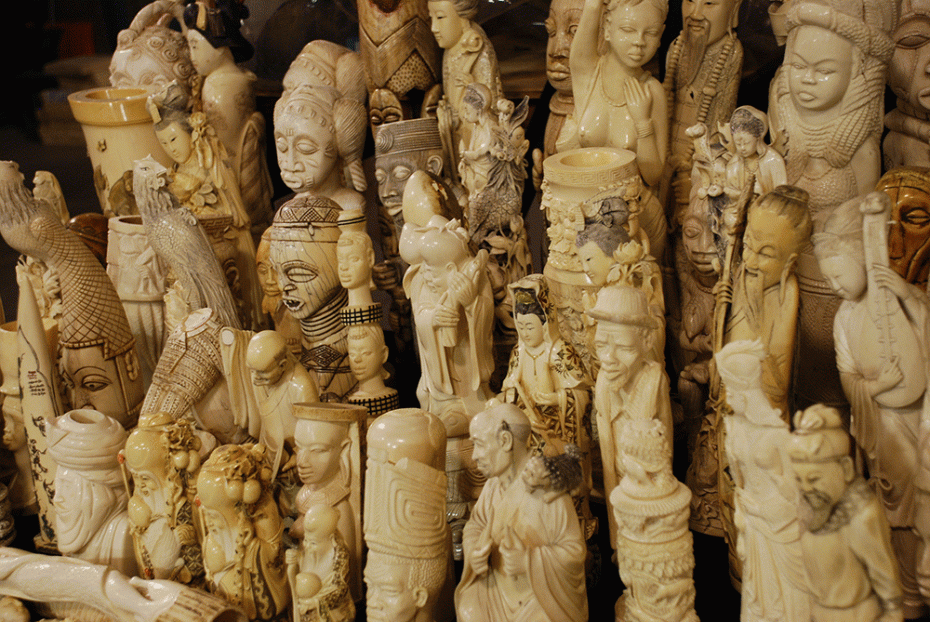You’re wandering through a market in Chinatown and a vendor offers to sell you an ivory figurine. Let’s say it’s carved in the likeness of Buddha, with a light-brown finish and a crack running down the side of his face. If you buy it, are you breaking the law?
To answer that question you’ll need a lawyer, a scientist, and an art historian at your side. That’s how complicated ivory-sale restrictions are in the United States. The legality of a transaction depends on a preposterous number of variables: What state is the market in? Where did the ivory come from? How old is it? When was it carved into its current form? Has it been altered or repaired since then? Through which port did the ivory enter the U.S.?
Part of the complexity, especially on the federal level, is a result of efforts to strengthen rules against importing and selling ivory. Poaching has been on the rise since 2008, with an estimated 35,000 elephants dying for their tusks in 2012 alone. At such rates, wild elephants could go extinct in a matter of decades. States have begun toughening their own laws, and recently State Representative Toni Atkins introduced a new measure to more strictly enforce the ivory ban in California.
Antiques can still be sold in New York, but only if they contain less than 20 percent ivory, and the seller has documentation proving the piece was manufactured before 1976. (The overwhelming majority of fake antiques are pure ivory figurines.)
“The existence of a legal market for ivory creates opportunities for parallel illegal markets to thrive,” writes Elly Pepper, a policy advocate for the Natural Resources Defense Council (which publishes Earthwire). “Because of California’s [current] law, too much ivory is slipping through the cracks and putting elephants’ lives at risk.”
NRDC had ivory expert Daniel Stiles check out markets in Los Angeles and San Francisco for about six months last year to estimate what proportion of the sales were illegal. The techniques he employed illustrate how difficult it is for buyers—or even honest sellers—to determine whether a piece of ivory can be sold on the up and up.
For example, it is generally OK to sell Asian ivory if it is more than 100 years old. As a result, sellers of new, illegal ivory use a variety of methods to make their wares look antique: They dip it in tea or coffee to stain it, bury it underground, rub it with sandpaper, or expose it to extreme heat to encourage cracking. When Stiles couldn’t spot any of those tricks, he called in an African-art expert to separate the genuine relics from modern contraband. (The art historian wasn’t impressed—he dubbed the worst pieces “ludicrous fakes” and “profoundly insulting jokes.”)
In cases where an art expert is stumped, the only remaining option is to date the ivory using expensive laboratory methods. Bomb-curve dating detects the presence of radioactive material from nuclear explosions in the mid-20th century. If an elephant was alive after humanity began splitting atoms, its ivory will let us know.
If someone like Stiles, one of the world’s foremost experts in determining the origin of ivory, has this much trouble, imagine what it’s like for customs agents and fish and wildlife officials, who are tasked with enforcing the morass of ivory laws at our ports and cities.
Stiles concluded that more than 77 percent of the 1,250 items he documented were illegal under California law, and approximately half were illegal under federal law. A few sellers he spoke with had been warned by law enforcement, but none had been threatened with prosecution, even though they couldn’t produce documentary evidence that their ivory was legal. Stiles says police are hesitant to make arrests given past failures.

“They have seized ivory on a couple of well-publicized occasions in California,” he says, “but then had to return it with no prosecutions when they could not prove the pieces were illegal.”
Conservationists are hopeful that ivory laws will soon be strengthened and simplified. New York and New Jersey have led the way; last August, New York banned the sale of almost all elephant, mammoth, and rhinoceros ivory. There are exceptions, but the ban doesn’t have the gaping loopholes that currently undermine federal law. Antiques can still be sold in New York, for example, but only if they contain less than 20 percent ivory, and the seller has documentation proving the piece was manufactured before 1976. (The overwhelming majority of fake antiques are pure ivory figurines.)
The new California bill adopts the same general scheme, with only a few minor differences in the details of the exemptions. If the state adopts the law, the nation’s three largest ivory markets, New York, Los Angeles, and San Francisco, will have simple and effective bans.
Until that time, the odds suggest you should steer clear of ivory. Actually, that’s probably good advice even after the law is passed.
“There is always the chance it came from a poached elephant—even if it’s technically legal,” Stiles says. “So if the buyer does not want to take the chance of contributing to killing elephants, don’t buy ivory.”
Who wants a bit of dead elephant on their bookcase, anyway? Not me.
This post originally appeared on Earthwire as “Demolishing the Ivory Tower” and is republished here under a Creative Commons license.



